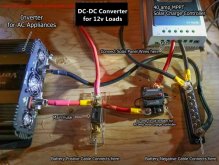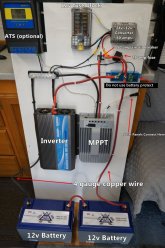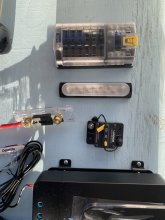CQLife
YaYa Gets Skooled
Ok so I’m not certain about correct fuses and wires.
I’m building the 24v DIY system with 2-12v 200ah life PO in series
I have the 400w panel Renogy system 4x100w which I plan to series and parallel with 40a Rover MPPT.
I will be going with the 24v 2000w inverter and the DC 24v to DC 12V 40A 480W Buck Transformer
I’m unsure if I should use the recommended 50a circuit breaker or the provided 40a bolt on fuse between battery and MPPT. There seems to be a bolt on main fuse probably much larger in the second picture demonstrating his system since the Victron component is no longer being used. and should I use 4g wire for this or the provided tray cable aluminum looking wires that appear to be 8g. Which seems too small in reference to what Will suggested. One mor question is what size fuse between the bus bar and the converter?
Thanks in advance for the guidance. This is really holding up everything and I want it right.
I’m building the 24v DIY system with 2-12v 200ah life PO in series
I have the 400w panel Renogy system 4x100w which I plan to series and parallel with 40a Rover MPPT.
I will be going with the 24v 2000w inverter and the DC 24v to DC 12V 40A 480W Buck Transformer
I’m unsure if I should use the recommended 50a circuit breaker or the provided 40a bolt on fuse between battery and MPPT. There seems to be a bolt on main fuse probably much larger in the second picture demonstrating his system since the Victron component is no longer being used. and should I use 4g wire for this or the provided tray cable aluminum looking wires that appear to be 8g. Which seems too small in reference to what Will suggested. One mor question is what size fuse between the bus bar and the converter?
Thanks in advance for the guidance. This is really holding up everything and I want it right.





